Finding the proper plants for areas where the lawn won’t grow or for ground areas that you feel are unattractive is important for the overall appearance of any garden.
Pink flowering groundcover plants are excellent for covering gaps in flower beds or as an alternative to traditional grass. There’s something about the color pink that makes a garden feel magical with a touch of romance.
If you feel that some areas of your garden need a little extra help, keep reading for advice on pink-flowering groundcover plants. This article has everything covered!
Table of Contents
Groundcover Plants With Pink Flowers
1. Groundcover Pink Roses
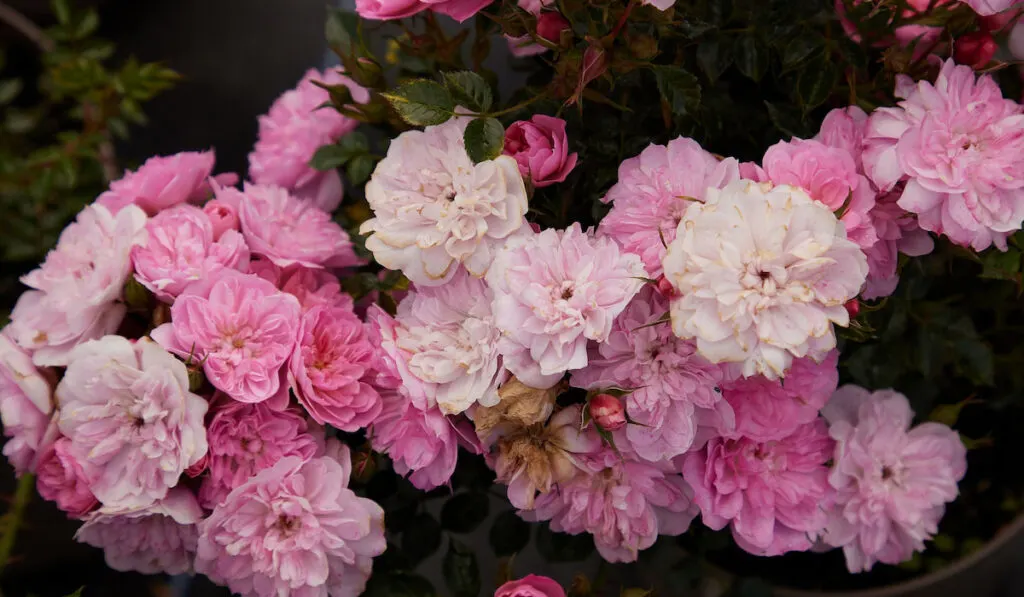
Roses are undeniably stunning, and I could spend all day debating their charm. To me, a rose is the definition of beauty.
Groundcover roses, also known as creeping roses, are a diverse group. While some grow low to the ground, others can be large and reach considerable heights.
But both varieties spread out across an area quite quickly.
All the roses in this group are mostly dense, have healthy foliage, and have fantastic vitality.
- ‘The Fairy’ rose is probably the most well-known rose used as a groundcover.
It is gorgeous in every way, from its soft pink hue and delicate petals to its exceptionally high blooming rate. Also, from June into November, it blooms continuously!
In 1993, ‘The Fairy’ won the Award of Garden Merit (AGM) – a valuable distinction awarded by the British Royal Horticultural Society.
- ‘The Granny’ rose is my new favorite variety.
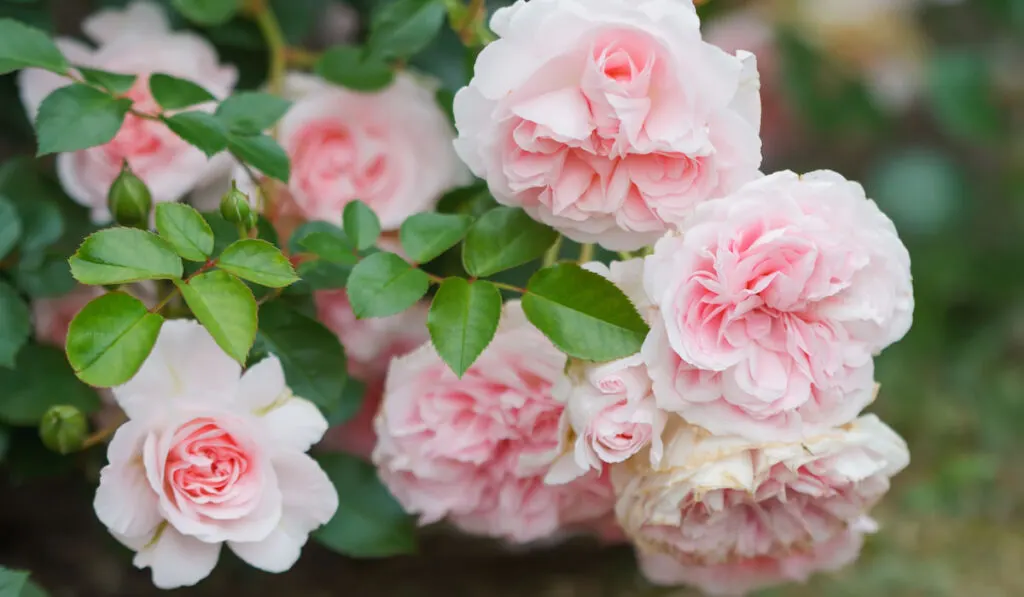
This magnificent groundcover rose gets completely covered in blossoms and grows tall and wide with healthy, shiny foliage.
‘The Granny’ looks great in various settings. While magnificent at the forefront of a large flowerbed, it is also splendid as a solitary showpiece covering empty garden spaces.
‘The Granny’ and ‘The Fairy’ are healthy, robust roses with high frost tolerance. These easy-to-handle roses are also a great place to start if you are a beginner in the garden.
| Name | Flowering Period | Key Information | Soil Tolerance | Flowers | Ultimate height |
| The Fairy | From June continuously until the first frost | Prefers full sun and partial shade. Heavy blooming, dense branching, high frost tolerance, grows quickly, undemanding. Award of Garden Merit (AGM) by the British Royal Horticultural Society. | Wide range of soils. Thrive in deep, humus-rich, moist but well-drained soil. | Light baby pink, small size | 2’ – 4’ |
| The Granny | From June continuously until the first frost | Prefers full sun and partial shade. Tall ground cover rose, healthy and hardy. The flowers stay on the bush for a long time. Grows wide. | Wide range of soils, thrive in deep, humus-rich, moist but well-drained soil. | Light baby pink, medium size | 2′ – 39″ |
2. Creeping Phlox (Phlox subulata)
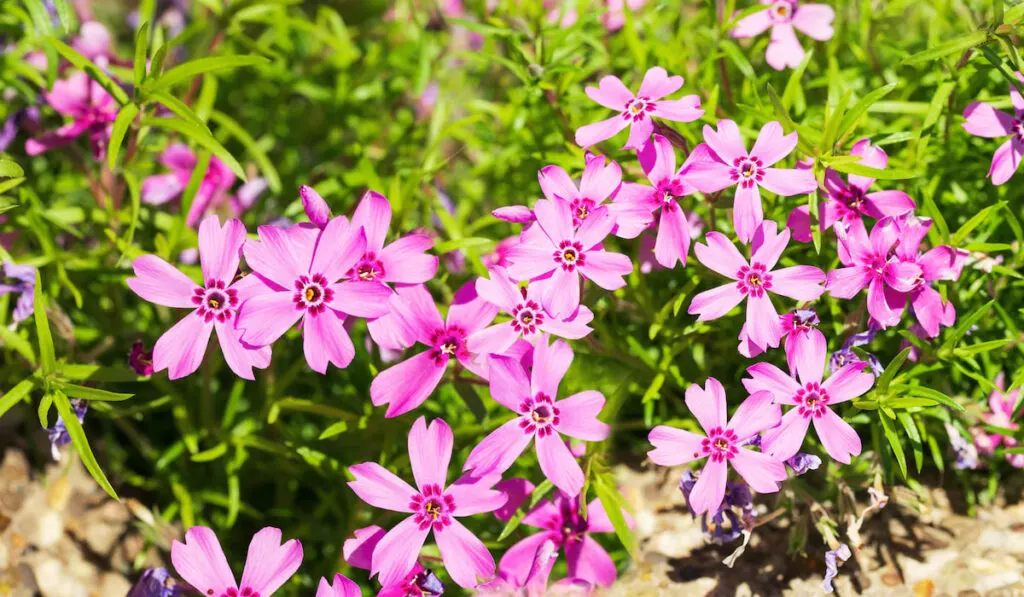
Phlox is a creeping perennial with a long-life span that comes in various hues. It will cover large garden areas in a thick carpet of blossoms from early spring.
This creeper is available in pink, white, blue, and purple tones.
The most significant advantage of phlox is its incredible versatility. You can plant it in rock gardens or along walkways to create eye-catching rainbow arrangements.
It’s hard to resist the fabulous fragrance of a phlox bloom, and butterflies and bees also love them.
The blossoming season starts in April and continues through June. They require very little in the way of soil and thrive in bright, sunny locations. Phlox grows successfully for many years in one place and forms large, impressive flowering clusters.
If you’re looking for pink Phlox, my top picks are:
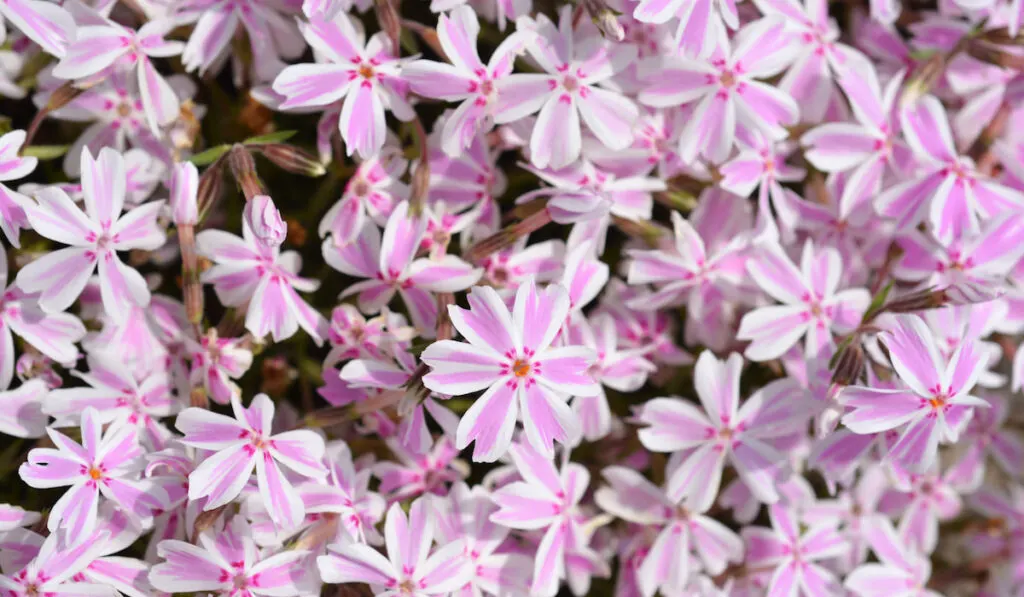
- ‘Candy Stripes’ Phlox
- ‘Emerald Pink’ Phlox
- ‘Amazing Grace’ Phlox
| Name | Flowering Period | Key Information | Soil Tolerance | Flowers | Height |
| ‘Candy Stripes’ Phlox | From April to June | Prefers full sun, drought tolerant, soil tolerant, little care evergreen | Chalk, loam, sand; well-drained soil | Light pink and white stripes | 4” – 6” |
| ‘Emerald Pink’ Phlox | From April to June | Prefers full sun, drought tolerant, soil tolerant, little care evergreen | Chalk, loam, sand; well-drained soil | Intensive purple-pink | 4” – 6” |
| ‘Amazing Grace’ Phlox | From April to June | Prefers full sun, drought tolerant, soil tolerant, little care evergreen | Chalk, loam, sand; well-drained soil | White-pale pink petals, with an intense amaranth eye | 4” – 6” |
3. Cranesbill Geranium (Geranium sanguinem and G. cinereum)
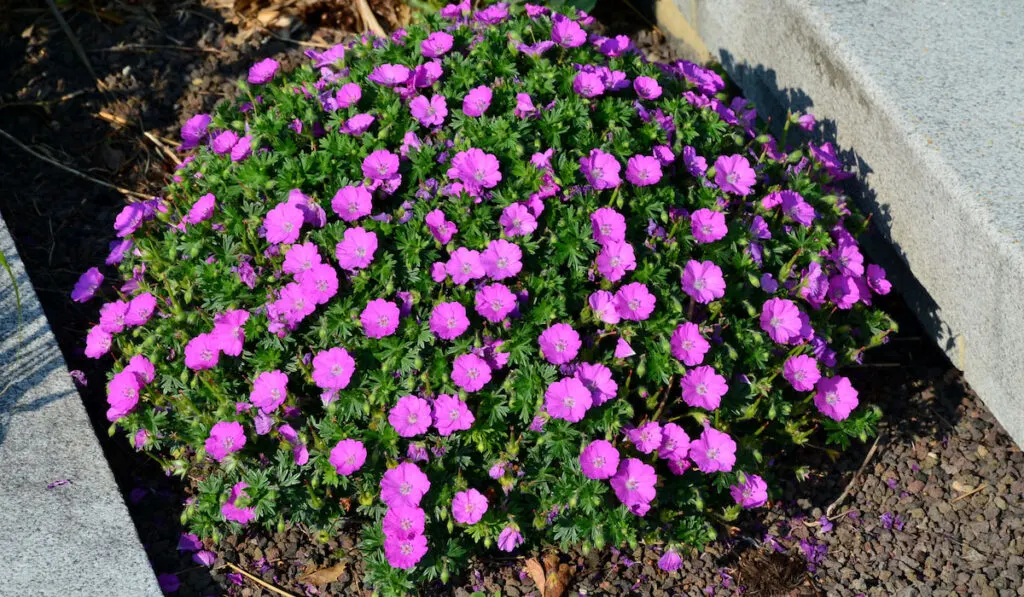
Geraniums are an exciting plant with around 450 species. Geraniums in the garden are respected for their attractive foliage and abundant flowering. They can quickly fill large, empty spaces with lovely, even coverage.
This lush cluster will transform into a blanket of charming flowers from May to September.
Geranium is a drought-tolerant perennial with medium water requirements. It prefers well-drained medium-fertility soils. It is a frost-resistant species that should be grown in a sunny or slightly shaded location.
Due to their impressive, long flowering, Geraniums are worth placing in exposed places, so everyone can admire their extraordinary beauty.
Some of the most interesting varieties of geranium, characterized by exceptionally abundant and long-lasting pink flowering, are:
- ‘Pink Pouffe’
- ‘Elke‘
- ‘Ballerina‘
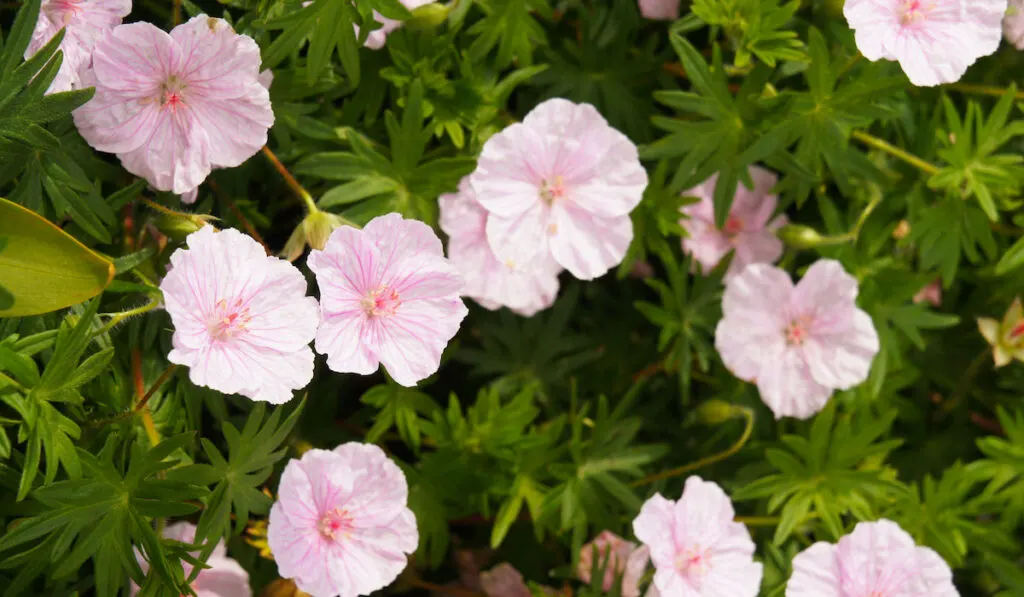
| Flowering Period | Key Information | Soil Tolerance | Flowers | Height | |
| Pink Pouffe | From June to Autumn | Prefers full sun and partial shade. Spectacular, long, and very heavy flowering. Low cultivation requirements, drought tolerant, resistant to frost. | Grows in any moderately fertile soil, drained soil. | Flowers of a delicate, pale pink shade, which are additionally decorated with darker veining. | 6” |
| Elke | From May until September | Prefers full sun and partial shade. Very little maintenance, soil tolerant, drought tolerant. | Grows in any moderately fertile soil, drained soil. | Intensely pink flowers with a cream edge of the petals and a distinct color of the veins. | 10” |
| Ballerina | From June to Autumn | Prefers full sun and partial shade. Drought tolerant, soil tolerant, easy to grow, attractive to butterflies, recipient of Award of Garden Merit (AGM) | Grows in any moderately fertile soil, drained soil. | The petals are light pink decorated with distinct dark veins and a dark purple eye in the center | 6” |
4. Heartleaf Bergenia (Bergenia sp.)
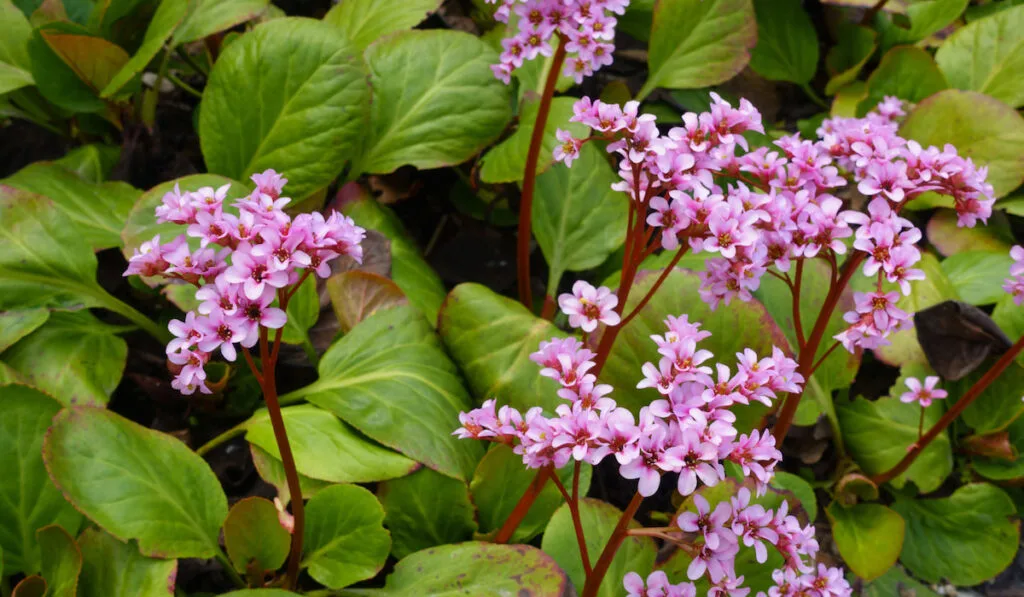
Two Bergenia species, Bergenia cordifolia and Bergenia ciliata are the most common types grown in gardens.
I especially like the pink blooming Bergenia cordifolia. It has very few requirements, making it ideal for beginning gardeners. At the same time, it blossoms beautifully.
Bergenia’s foliage is sometimes heart-shaped, oval, or circular. The leaves are thick in a shiny, rich green hue.
Inflorescences grow with clusters of several flowers, usually in the shape of a cup. They are very decorative, and you’ll usually see them in pink or white. People often pick Bergenia flowers to put in vases or add to bouquets.
When autumn arrives, the leaves of Bergenia turn to beautiful colors like red, brown, and purple. Bergenia is an evergreen plant, so its leaves do not fall and will decorate the garden all year.
| Name | Flowering Period | Key Information | Soil tolerance | Flowers | Height |
| Bergenia cordifolia | From April to May | Prefers full sun and partial shade. Heavy shade tolerant, soil tolerant, low cultivation requirements. | Chalk, loam, sand; thrive in deep, humus-rich, moist but well-drained soil. | Pink cup shape flowers | 1’-2’ |
5. Coral Bells (Heuchera sp.)
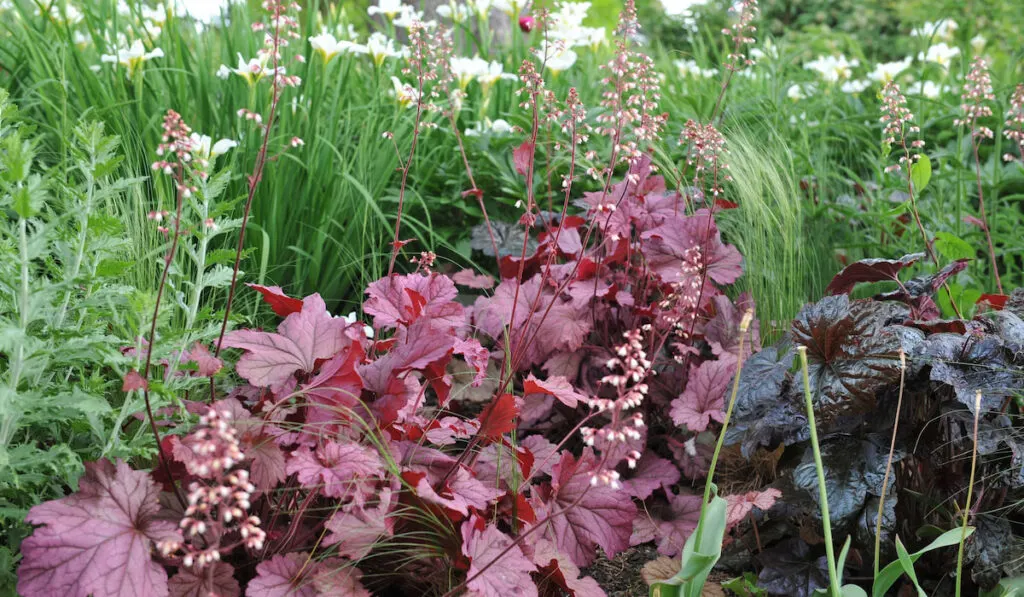
There are several hundred varieties of Heuchera around the world.
The leaves of this beautiful perennial can range in color from lime green, through green and orange, to crimson red and purple. Even black leaves are no problem for this queen of colorful foliage.
Not only is there a vast selection of leaf colors to choose from, but the number of possibilities in shape and size is equally extensive. They can range from petite to large and be heart-shaped, wavy, rounded, pointy, or maple-shaped.
As an easy-going perennial, Heuchera requires little attention when planted in a garden. Heuchera grows quickly in moist, fertile, humus-rich soils. It is essential to water Heuchera on hot days, preferably in the early morning or evening.
Heuchera prefers shade; however, some varieties may be grown in full sun.
Something to keep in mind is that the darker the leaves of the Heuchera, the less light it needs.
I’ve chosen three lovely varieties of Heuchera to demonstrate the variety of visual outcomes available. They look gorgeous in mixed planter arrangements with other colors of Heuchera, as well as Brunneras, Hostas, and decorative grasses.
Every variety I have chosen has delicate pink flowers, and their leaves are just amazing!
- Heuchera ‘Grape Timeless’
This beautiful variety of Heuchera has purple-plum leaves with just a hint of pink. Pink flowers growing above these unique leaves create a fantastic composition.
- Heuchera ‘Peppermint Spice‘
The ‘Peppermint Spice’ Heuchera is named so because of the beautiful shade of mint green that its leaves take on. In addition, its leaves have a silver coating and dark maroon veins, creating a unique look. Light pink flowers are a charming contrast to the green foliage.
- Heuchera ‘Sweet Tart‘
‘Sweet Tart’ is a step ahead in the development of Heuchera hybrids, with long flowering and unique color production. The lime-golden foliage is a stunning contrast to the deep pink, thick clusters of flowers that bloom from May to October.
The leaves of the ‘Sweet Tart’ Heuchera variety maintain their vivid, expressive color throughout the season and have a compact, dense form.
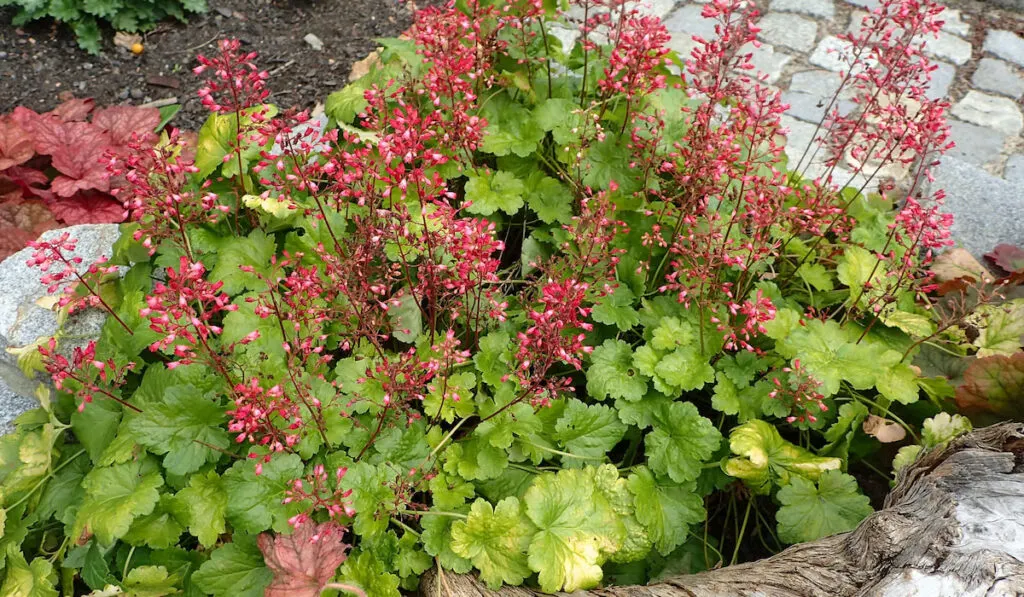
| Name | Flowering Period | Key Information | Soil Tolerance | Flowers & Leaves | Height |
| ‘Grape Timeless‘ | From June to August | Prefers full shade, partial shade, full sun; low cultivation requirements, thrives in dry shade, watering regularly promotes growth, good frost resistance. | Thrive in humus-rich, moist but drained soil. | Flowers of a delicate, pink shade, purple-plum leaves. | 8”-2’ |
| ‘Peppermint Spice‘ | From June to July | Prefers full shade and partial shade. Thrives in dry shade, requires very little maintenance, soil tolerant. | Thrive in humus-rich, moist but drained soil. | Flowers of a delicate, pink shade, mint green leaves with burgundy veins. | 8”-2’ |
| ‘Sweet Tart‘ | From May to October | Prefers full shade and partial shade. It thrives in dry shade, very little maintenance, and is soil tolerant. | Thrive in humus-rich, moist but drained soil | Flowers of a delicate, deep pink shade, lime-golden foliage | 4”-5” |
6. Pink Creeping Thyme
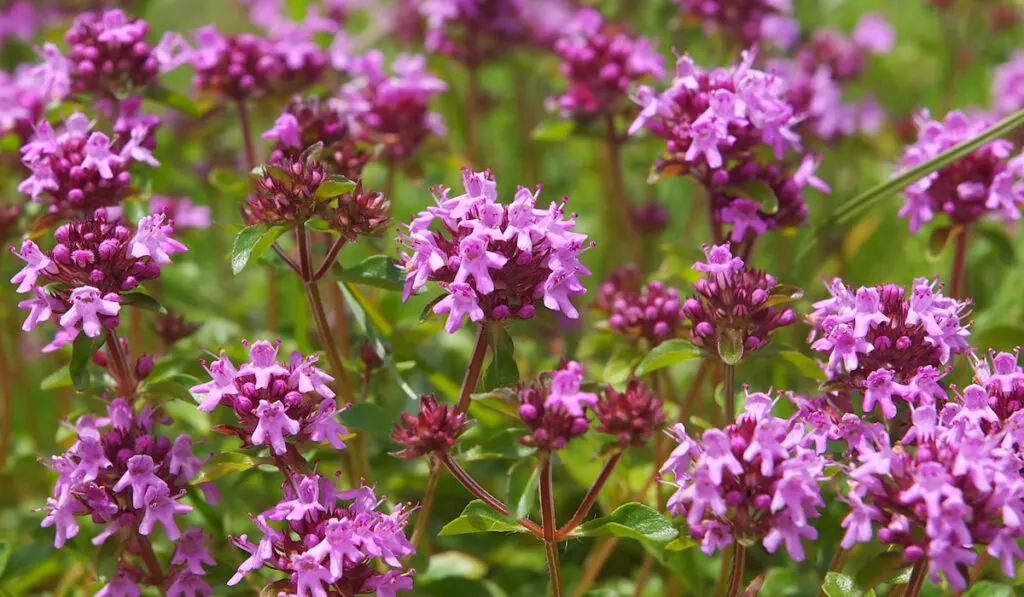
Pink creeping thyme is an excellent groundcover plant.
It creates perfectly flat patches of close, clingy leaves and stems. As the weather warms up in May and June, you’ll see creeping thyme bursting with tiny pink blooms.
Thyme thrives and flowers best in bright sunlight and prefers dry soil. It is an easy-to-grow species and does not require special attention.
It is also a frost-resistant and adaptable plant. Because of its low maintenance and compact growth, it is ideally suited for rock gardens, retaining walls, and green roofs.
A hint of thyme in the garden adds a rustic mountain feel to the setting.
| Name | Flowering Period | Key Information | Soil Tolerance | Flowers | Height |
| Pink Creeping Thyme | From May to June | Prefers full sun, heavy shade, tolerant soil, tolerant low water, needs low cultivation requirements, flowers attract butterflies and bees, Award of Garden Merit (AGM) by the British Royal Horticultural Society. | Chalk, loam, sand; well-drained soil | Tiny pink blooms | 2” |
7. Sedum spectabile
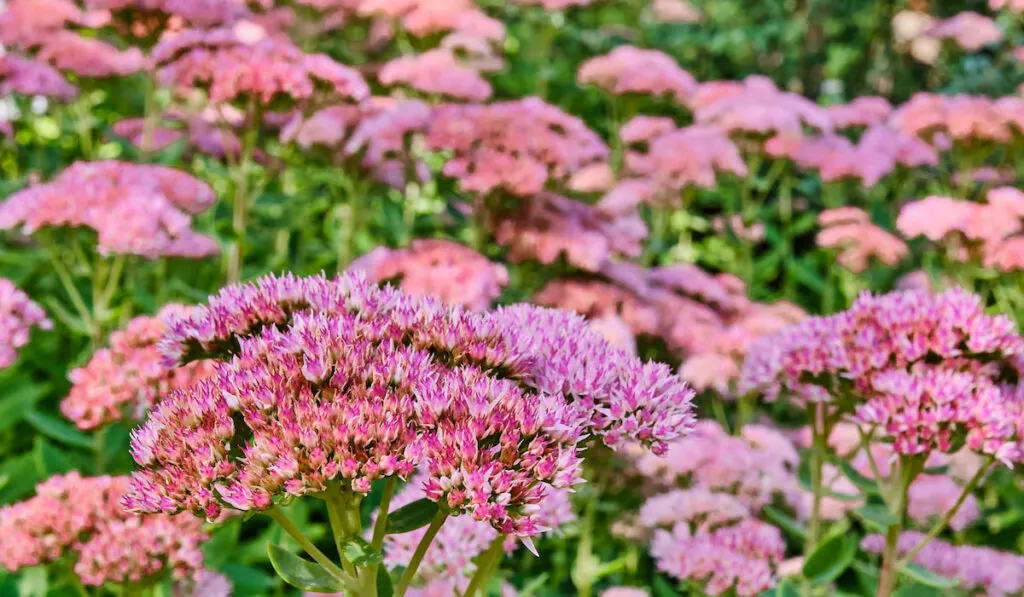
There are many species of Sedum, but they don’t look closely related to one another. Among them is the Sedum spectabile, distinguished by its splendor and size.
Sedum spectabile is a perennial plant that, once planted in the ground, will grow there for a long time.
Oval, thick leaves, occasionally glistening with a blue covering, arise on a thick, very stiff green stem.
Umbrella-shaped clusters of tiny pink or carmine flowers form on the plant and blossom from August to September. When grown in dense clumps, Sedum spectabile is spectacular.
Sedums are low-maintenance plants. They require a sunny location and soil that drains well.
Rather than sowing seeds, most young plants are grown from cuttings from more mature clumps.
| Name | Flowering Period | Key Information | Soil Tolerance | Flowers | Height |
| Sedum spectabile | From April to May | Prefers full sun, drought tolerant, soil tolerant, low cultivation requirements, high frost tolerance, attractive throughout the winter. | Chalk, loam, sand, well-drained soil. | Pink cup-shaped flowers | 1’-2’ |
Final thoughts
Groundcover plants are perennials or vines that spread and cover the ground with a dense blanket of branches, leaves, and flowers.
Groundcover plants are ideal for places where garden care is difficult, such as shady or difficult-to-reach areas. They are also suitable on slopes, around rocks, at the edges of paved surfaces, and in containers or flowerbeds.
Because of their dense growth, groundcover plants prevent weeds from taking over. But be aware that they may also become invasive, so be prepared to control them if necessary.
Resources
Both my wife and I are gardening enthusiasts and we have many species of plants and vegetables in our garden. Some of the information in this article is from my own experience.
- https://www.gardenia.net/plant/rose-the-fairy
- https://www.helpmefind.com/rose/l.php?
- https://www.gardenia.net/plant/phlox-subulata-candy-stripes-creeping-phlox
- https://www.gardenia.net/plant/phlox-subulata-emerald-pink-creeping-phlox
- https://www.gardenia.net/plant/phlox-subulata-amazing-grace
- https://www.rhs.org.uk/plants/336503/geranium-sanguineum-pink-pouffe/details
- https://www.gardenia.net/plant/geranium-elke-cranesbill
- https://www.gardenia.net/plant/geranium-cinereum-ballerina
- https://www.gardenia.net/plant/bergenia-cordifoliaheartleaf-bergenia
- https://www.gardenia.net/plant/heuchera-grape-timeless
- https://www.gardenia.net/plant/heuchera-peppermint-spice
- https://www.gardenia.net/plant/heuchera-sweet-tart-coral-bells
- https://www.gardenia.net/plant/thymus-serpyllum-pink-chintz
- https://www.aucklandbotanicgardens.co.nz/plants-for-auckland/plants/sedum-spectabile/
